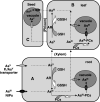Arsenite transport in plants
- PMID: 19350206
- PMCID: PMC11115966
- DOI: 10.1007/s00018-009-0021-7
Arsenite transport in plants
Abstract
Arsenic is a metalloid which is toxic to living organisms. Natural occurrence of arsenic and human activities have led to widespread contamination in many areas of the world, exposing a large section of the human population to potential arsenic poisoning. Arsenic intake can occur through consumption of contaminated crops and it is therefore important to understand the mechanisms of transport, metabolism and tolerance that plants display in response to arsenic. Plants are mainly exposed to the inorganic forms of arsenic, arsenate and arsenite. Recently, significant progress has been made in the identification and characterisation of proteins responsible for movement of arsenite into and within plants. Aquaporins of the NIP (nodulin26-like intrinsic protein) subfamily were shown to transport arsenite in planta and in heterologous systems. In this review, we will evaluate the implications of these new findings and assess how this may help in developing safer and more tolerant crops.
Figures



References
-
- Smedley PL, Kinniburgh DG. A review of the source, behaviour and distribution of arsenic in natural waters. Appl Geochem. 2002;17:517–568. doi: 10.1016/S0883-2927(02)00018-5. - DOI
-
- Brewstar MD. Removing arsenic from contaminated water. Water Environ Technol. 1994;4:54–57.
-
- Chatterjee A (1994) Ground water arsenic contamination in residential area and surroundings of P.N.Mitra Lane, Behala, Calcutta, due to industrial effluent discharge. PhD thesis, Jadavpur University, Calcutta, India
-
- Yarnell A (1983) Salvarsan. http://pubs.acs.org/cen/coverstory/83/8325/8325 salvarsan.html. Accessed Mar 2006
Publication types
MeSH terms
Substances
Grants and funding
LinkOut - more resources
Full Text Sources

